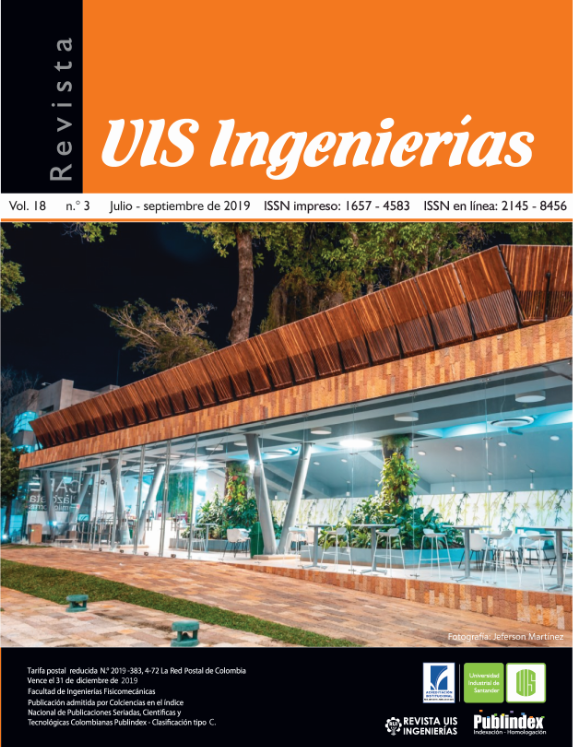Finite element analysis of a flange-type intern element of horizontal pressure vessel
Published 2019-05-06
Keywords
- mechanical stress,
- finite element analysis,
- Ansys,
- pressure vessel
How to Cite
Abstract
This work presents the stress analysis at the flange-type intern element in a pressure vessel which works at 175 °F and 135 psig of pressure, by using the Finite Element Method. This equipment belongs to flow stations and has the main function of separating gas and water from a production fluid. By effect of a contingency, some cracks may arise in the material between the holes of the intern. The mechanical stress distribution around the holes of the intern was estimated using static structural analysis of ANSYS v18.2. The results show that the stress concentrator is located at the intern central orifices, and the range of stress is 25 MPa to 137.5 MPa. In order to continue the operation of the equipment, it is necessary to weld a reinforcing pad.
Downloads
References
[2] A. M. Senthil Anbazhagan and M. Dev Anand, “Design and Crack Analysis of Pressure Vessel Saddles Using Finite Element Method,” Indian J. Sci. Technol., vol. 9, no. 21, pp. 38–47, Jun. 2016. doi: 10.17485/ijst/2016/v9i21/90567.
[3] H. A. Rolón Ortiz, C. Acevedo Peñaloza, and Y. Villamizar González, “Modelado matemático y simulación del comportamiento de una turbina hidrocinética tipo darrieus; consideraciones de diseño,” Respuestas, vol. 23, no. 1, pp. 14–18, Jul. 2018. doi:10.22463/0122820X.1492.
[4] O. A. González-Estrada, S. Natarajan, and C. Graciano, “Reconstrucción de tensiones para el método de elementos finitos con mallas poligonales,” Rev. UIS Ing., vol. 16, no. 1, pp. 23–34, 2017. doi: 10.18273/revuin.v16n1-2017003.
[5] J. Martínez, E. Casanova, C. Graciano, and O. A. González-Estrada, “Análisis de sensibilidad de un miembro a compresión vía el método de Monte Carlo,” Rev. UIS Ing., vol. 17, no. 2, pp. 179–184, Oct. 2017. doi: 10.18273/revuin.v17n2-2018016.
[6] K. Molina, D. Ortega, M. Martínez, W. Pinto Hernández, and O. A. González-Estrada, “Modelado de la interacción fluido estructura (FSI) para el diseño de una turbina eólica HAWT,” Rev. UIS Ing., vol. 17, no. 2, pp. 269–282, 2018. doi: 10.18273/revuin.v17n2-2018023.
[7] V. V Wadkar, S. S. Malgave, D. D. Patil, H. S. Bhore, and P. P. Gavade, “Design And Analysis Of Pressure Vessel Using Ansys,” J. Mech. Eng. Technol., vol. 3, no. 2, pp. 1–13, 2015.
[8] M. Waghare, “Taking Pressure Vessels From Cradle To Grave Seminar Inspection Of Pressure Vessels To ASME Section VIII Div. 1,” 2011.
[9] M. A. Guerrero, C. Betegón, and J. Belzunce, “Fracture analysis of a pressure vessel made of high strength steel (HSS),” Eng. Fail. Anal., vol. 15, no. 3, pp. 208–219, 2008. doi: 10.1016/j.engfailanal.2007.06.006.
[10] C. Wüthrich, “Crack opening areas in pressure vessels and pipes,” Eng. Fract. Mech., vol. 18, no. 5, pp. 1049–1057, Jan. 1983. doi: 10.1016/0013-7944(83)90076-0.
[11] American Society of Mechanical Engineers. Boiler and Pressure Vessel Committee., BPVC Section VIII-Rules for Construction of Pressure Vessels Division 1. ASME, 2017.
[12] E. Marco Esteban, “Metodología para el análisis a fatiga mediante el código Pro Engineer: aplicación a un eje ferroviario,” Universidad Carlos III de Madrid, 2010.
[13] ANSYS Inc, ANSYS® Academic Research Mechanical, Release 18.1, Help System. ANSYS, Inc.
[14] R. Goncalves, Introducción al Análisis de Esfuerzos, 3rd ed. Caracas: Equinoccio, 2011.


